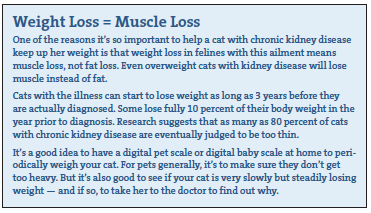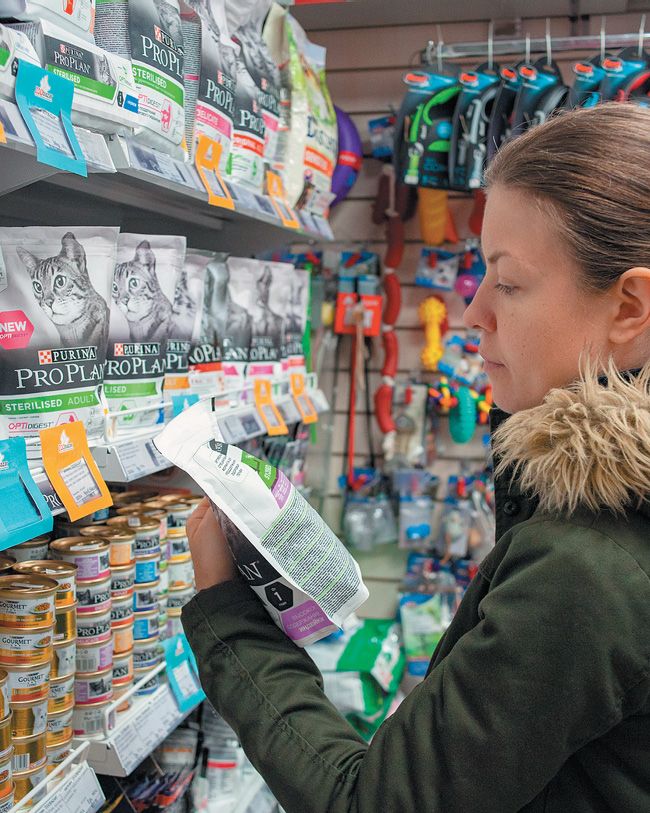Three in 10 cats over the age of 10 have chronic kidney disease, and that number rises to as many as eight in 10 for cats over the age of 15. That makes it one of the most common illnesses to befall our feline pets — and one of their biggest killers. But feeding the right diet can prolong the life of a cat with kidney disease, along with her quality of life.
The right diet cannot be found at the store. Only a diet prescribed by a veterinarian contains the optimal balance of nutrients to keep your cat’s kidneys from being over-taxed in a diseased state. Such a therapeutic diet will generally contain less phosphorus, sodium, and protein than you’ll find in cat food at the supermarket, and often more calories and omega-3 fatty acids — an appropriate balance for vulnerable kidneys. How appropriate?
 In a study conducted at the University of Minnesota’s College of Veterinary Medicine, none of the cats with mid-stage kidney disease who were fed prescribed, therapeutic diets developed any overt signs of kidney failure over a two-year period. But more than one in four cats fed regular diets died. The majority of them were euthanized because of their worsening condition. Another study conducted by veterinarians at the Netherlands’ Utrecht University found that older cats with kidney failure who were fed therapeutic diets lived an average of nine months longer than those who were not. Cats fed a therapeutic diet containing an omega-3 fatty acid known as EPA lived an average of 16 months longer.
In a study conducted at the University of Minnesota’s College of Veterinary Medicine, none of the cats with mid-stage kidney disease who were fed prescribed, therapeutic diets developed any overt signs of kidney failure over a two-year period. But more than one in four cats fed regular diets died. The majority of them were euthanized because of their worsening condition. Another study conducted by veterinarians at the Netherlands’ Utrecht University found that older cats with kidney failure who were fed therapeutic diets lived an average of nine months longer than those who were not. Cats fed a therapeutic diet containing an omega-3 fatty acid known as EPA lived an average of 16 months longer.
The right therapeutic diet for your particular cat
There are at least 25 different therapeutic diets that a veterinarian can prescribe for a cat with kidney disease. Even though they have less of certain nutrients and more of others than diets you’ll find at the store, they vary in their levels of minerals, calories, protein, and fats. Your pet’s veterinarian will choose one that she feels best suits your cat’s health profile at her stage of the disease, which could potentially go on for years. In making a prescribing decision, the vet will also consider your cat’s body condition score — whether she weighs less than she should and has less muscle mass than she should, and to what degree.
Note that different therapeutic diets for chronic kidney disease have different flavors and textures, and that will play into the prescribing decision, too, depending on your pet’s preferences. In addition to dry kibble, there are chunks, patés, and stews — any one of which your cat might find more appealing.
What if your cat is not eating enough?
A big problem for cats with chronic kidney disease, especially as it progresses, can be a loss of appetite. Fortunately, drugs are now available that will help stimulate your pet’s desire to eat.
Anti-nausea drugs may also help a cat eat better. As the disease worsens, toxins build up in the blood because they are not filtered out by the kidneys to be sent from the body via the urine. That can make a cat feel extremely nauseated, which competes with feeling hungry enough to ingest the nutrients and calories so necessary to forestall kidney disease’s advance. (In some cases, a feeding tube is necessary to bypass actual eating, and cat parents are taught at the vet’s office how to use one at home.)
Kidney disease can’t be cured. But the right diet, along with the right medicines to help her appetite, can go a long way to let your cat live her best life longer.




